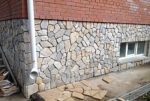Decorative panels for exterior walls. Finishing the house with plastic panels under the stone
Updated:
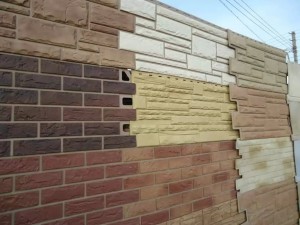 2016-09-23
2016-09-23
Stone effect panels for exterior finish are now being used much more frequently. Why? They are affordable, easy to install and easy to use. In addition, they are presented in many types, textures and colors, which makes them a leader among others. facing materials. What types of cladding panels should be used and how they are installed will be described below. And in general, is it worth buying a facing panel under a stone?
Stone effect panels have an important task - to satisfy the needs of the client in terms of external aspects and technical characteristics. Professional paneling at home often allows you to do this. But is this cooker right for you and will the price be satisfactory for your budget?
Exterior cladding at home can be a real problem for those who do not know which material is best to use. Where to start? To date, there are almost a dozen popular types of cladding. Which of them are the most profitable?
It must be understood that not only externally beautiful materials are used for exterior decoration, but at the same time practical structural elements. An additional layer of facade should not be a decision for a year. So that the new layer does not have to be changed soon, the selection of the cladding should be approached with all seriousness.
The most profitable options should correspond to the price-quality ratio. The following are the most common types of finishes.
Finish options
 There are only two types of materials that are used for exterior cladding - natural and artificial.
There are only two types of materials that are used for exterior cladding - natural and artificial.
Finishing with natural elements will cost at least 2 times more. This type of cladding includes wood, stone, glass. Typically, these materials are used for facing work in small areas, such as one-story houses and other buildings. They have a long service life - up to 10-20 years - if they are looked after. Over time, the impregnation will fade, and the protective layers will crumble, then this outer layer will have to be replaced. Although these types of house cladding are still popular, they have been replaced by new materials - artificial ones.
The most profitable option for repair and decorative work has become polymer elements for house cladding. Facing of these artificial materials became popular some time after their appearance. Inexpensive PVC and fiber cement panels perfectly withstand even the worst weather for a long period. Heat, cold, wind or slush will not affect the decorative qualities of this type of cladding.
Of the artificial materials, it is worth highlighting the PVC panels under the stone. Visually, they are almost identical to natural stone, they can even repeat the color and luster of some minerals. Such decorative elements are quite simply mounted on the facade of the house from the outside with the help of a crate. But this finishing option is not limited to the texture of the stone. You can choose panels for wood, metal, brick of almost any color. One of the best manufacturers such products are German companies. Neither in the photo, nor in a personal assessment, it is almost impossible to distinguish natural stone from a texture made of PVC.
In addition, there are also fiber cement panels. They repeat the stone texture just as realistically as PVC, only they suggest a slightly different type of installation. The only drawback of this material is the absorption of moisture. Its porous structure requires additional drainage systems, as well as a layer of waterproofing. But otherwise, fiber cement is an incredibly reliable option for the exterior of a home.
Natural materials for facing the house outside are used much less frequently. One of the few options can be considered MDF wood panels under the stone. The use of stone for facade decoration has been practiced for a long time. And this type of finish is still in vogue. MDF - relatively cheap material, which can visually replace even a stone. However, there may be problems with humidity. High humidity quickly spoils such a cladding, so you will have to use a waterproofing layer to protect it from the damaging effects of moisture.
Nuances during installation
 Now it is very popular to use decorative panels under the stone. They give a solid and austere look to the building. But you need to follow some rules in order to end up with a high-quality facade:
Now it is very popular to use decorative panels under the stone. They give a solid and austere look to the building. But you need to follow some rules in order to end up with a high-quality facade:
- Finishing the house outside should be carried out in dry, warm weather.
- Panels under the stone lay out only the main part of the facade. The plinth needs to be lined special type panels.
- Finishing with PVC panels can be done independently. For this, there are special installation instructions that are included in the kit. To get the same appearance panels, as in the photo in the instructions, you should follow all the recommendations of the manufacturer.
- When installing artificial elements between them, it is necessary to leave a small gap. During operation, they can expand and, in order not to damage neighboring elements, they will need a little space.
- Plastic panels under the stone are mounted on a special crate made of metal or wood. It is worth paying attention to its protection from moisture.
The most popular type of facade decoration is artificial stone.
Such cladding can be obtained using PVC, MDF and fiber cement panels. Almost all types can be mounted personally, but to speed up the process it is recommended to invite a team of specialists. Upon completion of the work, even a nondescript building will become more solid and interesting in appearance.
Exterior decoration of buildings is one of the key stages of private and multi-storey construction. In the modern building materials market, you can find various cladding options, however, facade panels are the most popular.
This product is represented by a diverse range of models, respectively, the buyer can give his home an original appearance and personality. Apart from architectural features, the material reliably protects wall structures from negative influences environment, provides additional thermal insulation of internal premises.
Separation of facade panels according to purpose
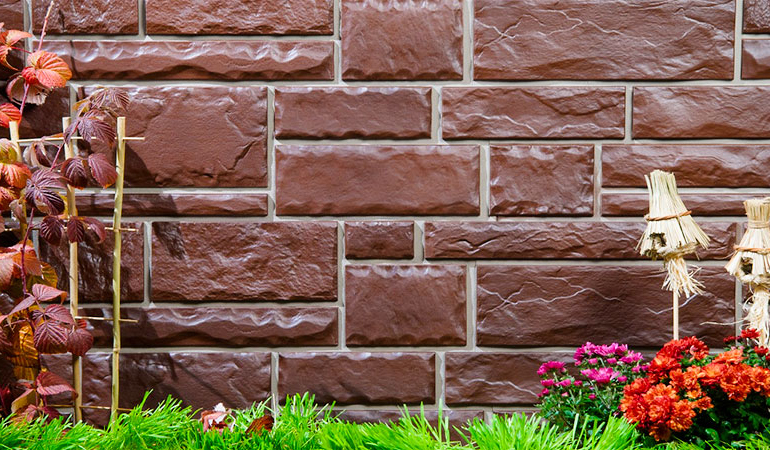
Panels for exterior facade decoration can be divided into two categories, depending on the intended use. It looks like this:
Wall
These are large panels designed for cladding wall structures. With impressive dimensions, such elements have a minimum weight: up to 5 kg, Accordingly, even one person can handle their installation.
Basement
Such panels are designed to protect the most vulnerable part of the building - the basement. Therefore, the material is impregnated with a special composition that is resistant to a humid environment and resists the formation of pathogenic microflora.
Such models look much thicker, have a denser structure. When installing basement panels, a layer of heat and waterproofing must be laid.
It is possible to install plinth panels only at temperatures above zero degrees, for wall facades - compliance with this condition is optional.
Characteristics by type of material
Facade panels are presented on the construction market with a very diverse range of models. Used in the manufacture of products different kinds raw materials, which affects not only the appearance, but also the technical properties of the finished panels.
According to the type of material used, they are divided into the following groups:
Plastic facade materials (PVC)
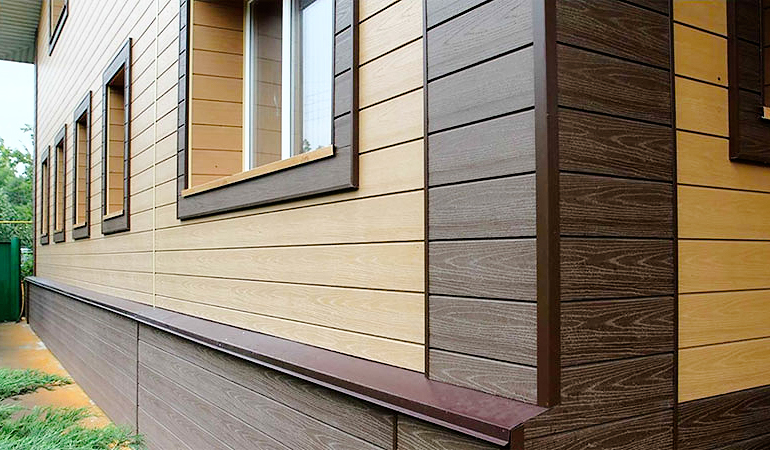
In fact, this is a type of siding with a denser structure. As a result, a rather rigid and high-strength material is obtained, resistant to any external influences. It should be noted that plastic panels have a solid service life, during which they do not lose their original properties and presentable appearance.
Key Benefits facade panels from plastic are a wide palette of shades and the absence of special requirements for the care of the material.
Exterior Vinyl Panels
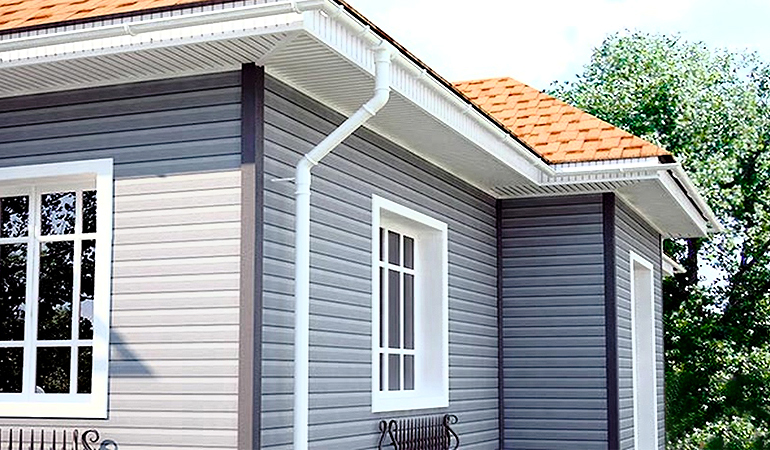
This category is considered the most demanded in the market of building materials. The panels are made from artificial raw materials, where 80% is polyvinyl chloride. For resistance to mechanical stress, modifiers are added to the composition, the desired color is achieved with pigment paints.
Durability - up to 30 years old.
Operating temperatures -50 - +50 degrees.
Fireproof - G1.
Waterproof.
The material is easy to cut.
Lightness - weight 5 kg/sq.m
Not subject to rotting and corrosion.
Ease of installation and repair.
Additional protection of the house from thermal losses. Coefficient of thermal conductivity - 0.16 W/m*K.
Resistant to ultraviolet radiation, does not lose color.
The production technology of vinyl panels allows the use of recycled raw materials ( no more than 5%), which reduces the cost of finished products.
Polypropylene wall finishing materials

This is a popular type of plinth panels created on a polyvinyl chloride basis. The material is made in the form of thin horizontal strips, which are convenient for installation and are sold in an affordable price segment.
The use of polypropylene panels gives the building an original appearance, however, the material has a significant drawback: high sensitivity to mechanical damage. In addition, a layer of insulation must be laid under such panels.
Ceramic (clay) products for facade decoration

Such panels are called clay and belong to the most popular category. finishing materials for facade cladding. The product is based on cement, to which silicate materials or synthetic fibers are added, which ensures high strength of the finished panels and resistance to any external factors and mechanical damage.
In addition, the undeniable advantages include environmental safety and a wide range of textures. A clear disadvantage is the weight, which is noticeably higher compared to other models.
Fiber cement boards - natural composite material
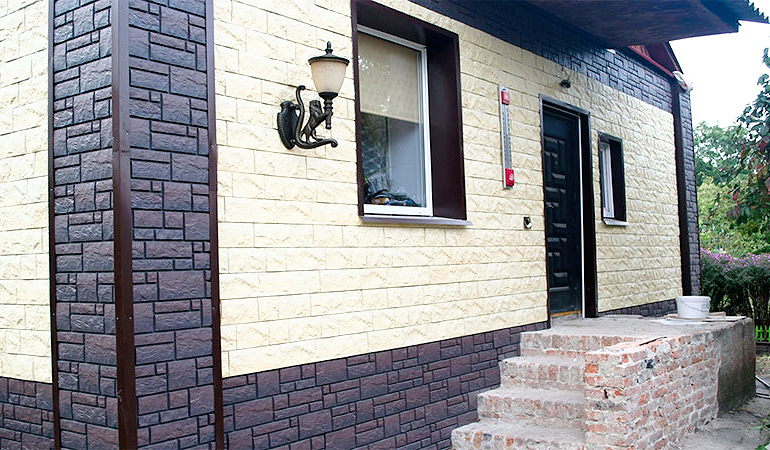
The products of this group are a fiber cement base reinforced with metal or polymer fibers. Such models have high rates of sound insulation, prevent heat loss. In appearance, the material usually imitates brickwork or lining natural stone.
Life time - 20 years.
Frost resistance - 100 cycles.
Does not corrode and rot.
Does not change from ultraviolet radiation(in the composition of paints - resins and substances-absorbers of ultraviolet rays).
Not flammable - NG.
Withstand temperature fluctuations.
The components of this plate do not contain substances harmful to health and the environment.
It is possible to restore any geometry of the facade, eliminate irregularities without preliminary preparation of the wall surface.
Reduce heating costs. Coefficient of thermal conductivity - 0.12 kW/m* K
Bending strength - 21.5 MPa.
Noise absorption coefficient - 29 dB.
Increase the maintenance-free service life of building facades.
At the same time, manufacturers offer more 30 variations color palette for freedom of choice. The disadvantages of fiber cement panels include increased weight, which makes installation impossible without first strengthening the wall structures.
Metal front panels (aluminum coated with polymers)
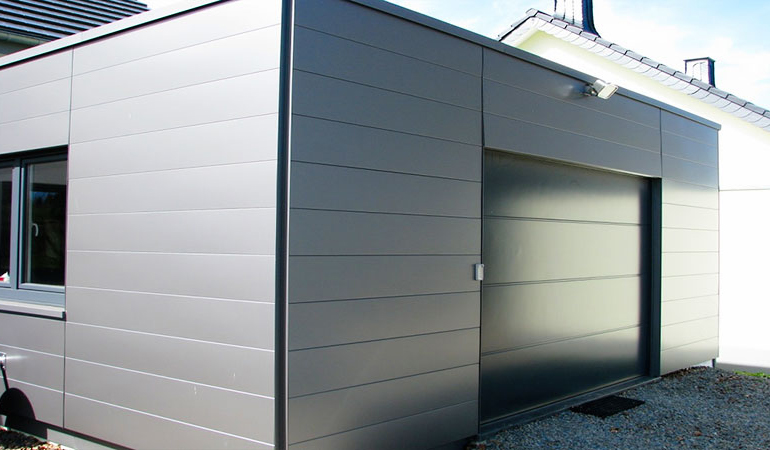
This category includes panels made of galvanized or stainless steel, however, the most common material is polymer-coated aluminum. Such panels are often referred to as composite panels because of the multilayer structure. It looks like this: the outer sides are made of aluminum coated with an anti-corrosion coating. In the middle is a mineral filler made of non-combustible material.
Specifications
Durability - service life - 30 and more years.
Frost resistance - up to 50 cycles.
Waterproof.
Are not exposed to corrosion.
Fire safety - NG.
Do not deform under temperature changes. Operating range from -50 to +50 degrees.
Easily mounted.
They have different colors and finishes.
Noise absorption coefficient - up to 20 dB.
High impact resistance - 50 kg/cm.
Resistance to acids and alkalis.
Bending strength* - 118 MPa.
This structure provides the panels with high rigidity and resistance to dynamic loads. The polymeric covering protects a basis from any external influences.
Wood fiber materials for protective and decorative cladding

In fact, wooden facade panels (planken) resemble clapboard, but the key difference is the “flush” fastening of the elements. The result is natural material, which practically does not collapse under the influence of external factors.
Life time - 10-15 years old.
Frost resistance - 100 cycles.
Due to the high density, there is no deformation, cracking of the panels.
Environmentally friendly material.
Provides thermal protection and energy saving. Coefficient of thermal conductivity: 0.15 W/m*K.
Provides sound insulation - sound insulation coefficient - 30 dB.
Bending strength - 45 MPa.
Ease of installation.
Such sheathing can last for several decades without collapsing, while being a completely natural material.
Natural stone panels
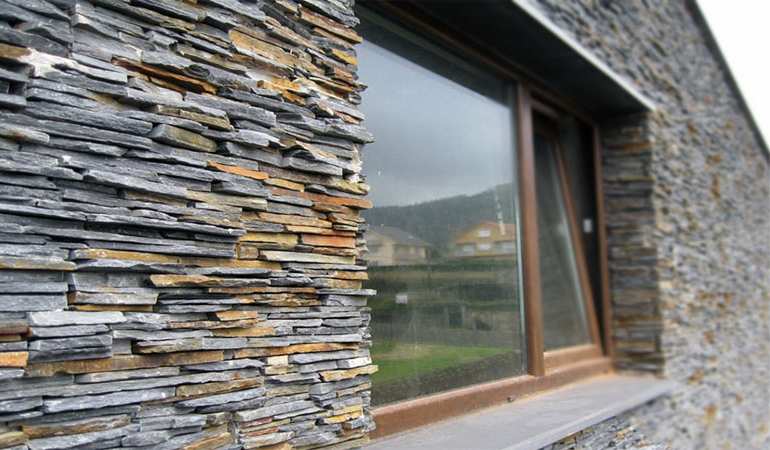
In structure, this product is a conventional composite panel, where the outer side is finished with a layer of natural stone. The panels have absolute incombustibility, resistance to any external influences, frost resistance and bending strength.
The disadvantages include big weight and poor soundproofing.
Facade porcelain stoneware - a reliable solution for ventilated structures

In this case, the outer side of the panel is finished with porcelain stoneware - an artificial material that creates a complete imitation natural stone. Products have high frost resistance, wear resistance and neutrality to any aggressive environment. The use of such panels significantly expands the horizons of architectural fantasy.
Durability - 50 years.
Frost resistance - 100 cycles.
Low water absorption - 0,02% .
Resistant to UV radiation.
Resistant to acids and alkalis (except hydrofluoric acid and its derivatives).
Fire safety - NG.
Bending strength - 30 MPa.
Resistant to temperature changes. Working temperatures: -50 - +60 degrees.
Easy replacement of damaged plates.
The disadvantages of porcelain stoneware facade slabs include high cost.
Glass panels for cladding facades of buildings

In the manufacture of products used fiberglass with the addition of various resins. The panels have a lot of undeniable advantages, according to the texture they can imitate any natural surface.
Products attract attention with a presentable appearance and a wide palette of colors, however, they can repel buyers with a high cost.
Wall sandwich panels (for suspended facades)
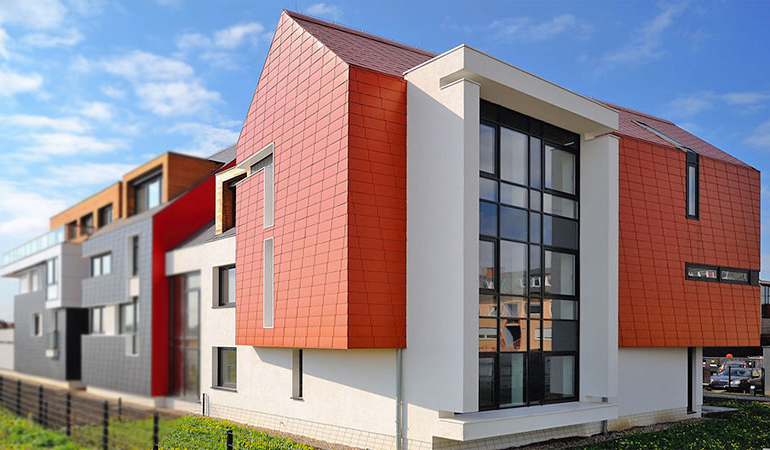
Such products are used for the installation of hinged facades, it is a multilayer structure, where there is a layer of insulation between the sheets of metal. The material is often used in the private sector, due to its low cost, quick installation and relatively good technical characteristics.
Durability - up to 30 and more years.
Operating temperatures - 180 - +100 degrees.
Fire safety - G1.
Environmentally friendly.
Are not subject to rotting and corrosion.
Protect against heat loss - thermal conductivity 0.02 W/(m.K).
Bending strength - 24.3 MPa.
Moisture swelling - 1,86 % .
In addition to the raw materials, facade panels are divided according to other criteria.
Popular Structures
![]()
Panels for exterior finish wall structures may vary in texture. Models that are a complete imitation of natural building materials are very popular. For example:
Under brick (clinker)
Initially, clinker tiles were developed for sidewalks, but due to their high technical specifications has found application in the decoration of wall structures. The material accurately copies brickwork, imitating an aged surface or firing marks. Thanks to this, you can give the house any architectural style: from ancient castle to a modern cottage.
Under the stone
These models imitate wall decoration with natural stone. The panels look beautiful and presentable, can be installed on aluminum profile or glued with special compounds directly to the wall structures.
Under the tree
Such panels are an exact imitation of precious wood. This texture is considered quite popular, therefore it is found on all types of wall panels.
Choosing the right texture, you can give the building any appearance, while saving on the use of natural building materials.
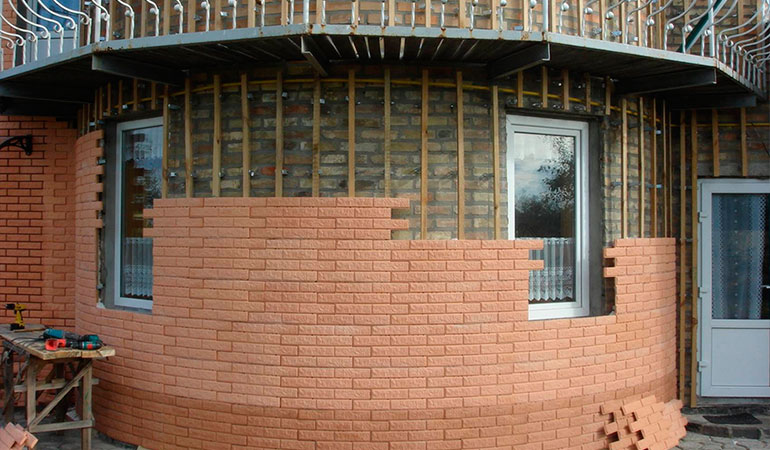
Advantages and disadvantages of panels for facades
Panels can be made from various raw materials, sometimes creating an exact imitation of natural materials: wood, stone. In addition, there are panels of different sizes and structures on the market. However, each species has its own strengths and weaknesses.
To the undeniable benefits facade panels include the following factors:
Absolute protection of the facade of the building from any natural phenomena including sudden temperature changes.
All panels, without exception, are made of artificial material, which is immune to corrosion and the appearance of fungus, does not fade from prolonged exposure to direct sunlight, and maintains a pleasant microclimate in the premises.
Installation does not require preparation, finishing work can be performed in all weather conditions.
For fixing, you can use any fasteners: staples, nails, screws.
During installation, horizontal and vertical arrangement of panels is allowed.
Some models create a complete imitation of wall cladding with natural materials.
Facade panels can be used to reconstruct dilapidated buildings and structures, breathing new life into them.
From explicit shortcomings the following can be distinguished:
Installation of some models requires the involvement of professionals, which significantly increases the cost of work.
Certain types of products are not suitable for regions with harsh climatic conditions.
In addition, facade panels for decorative finishes have a fairly high cost.
Features of the installation of facade panels

One of the key advantages of facade panels is the ability to install them yourself, without the involvement of specialists. There are three main finishing options:
Straight
In this case, the cladding is laid immediately on the surface of the walls. It is important to understand that this technology is only suitable for perfectly flat surfaces. Clinker panels are excellent for direct laying, which perform the function of additional insulation and decorative finishes.
On the crate
This method is suitable for all types of facade panels. In this case, the alignment of the walls will also be required, albeit not as thorough as in the previous version.
For special fasteners
This option is suitable for walls where it is planned to install an additional layer of thermal insulation. In this case, the panels are joined together by a system of built-in fasteners. The system is ideal for arranging ventilated facades.
In most cases, the installation of wall panels resembles the assembly of a children's puzzle, where the plates are joined together and fixed with fasteners.
Reliable manufacturers tested by time

When choosing a building material, the main thing is to find good manufacturer. Wall panels are in high demand, so there are a lot of fakes on the market. Among the proven manufacturers with a good reputation include the products of such brands:
Alta Profile
This is a domestic manufacturer, one of the first to start producing wall facade panels in Russia. The company has its own production facilities, carefully monitors the quality of its products. As a result, consumers receive high-quality facade panels at affordable prices.
deck
The birthplace of the brand is Germany. For a European manufacturer, Deke facade panels are sold at surprisingly low prices, while traditionally impressing with high quality and long service life.
This is a Japanese brand, which is one of the absolute leaders in the Russian construction market. Panels from this manufacturer 90% composed of quartz and cement, the surface has a porous structure. As a result, the products have high strength and frost resistance. The front part is covered with a ceramic layer, which makes the panels resistant to any external environment.
Another Japanese manufacturer that has won the trust of Russian buyers. In the manufacture of products used wood fibers, quartz, cement, mica. The highlight of this company is the absence of chemical components and additives of inorganic origin.
This is a trademark of the Russian company Terna Polymer. The panels are produced on an automated production line using high-tech equipment. The company produces wall and plinth panels of various colors and textures.
Russian manufacturer working on German technologies. The product is based on polyvinyl chloride, which allows you to give finished products any texture.
WANDESTEIN
This is a trademark of a Russian-German enterprise. The range of the manufacturer includes wall and basement facade panels, has several collections.
Products of all manufacturers have international quality certificates.
The photo shows samples of private houses with decoration from the materials discussed in this article.
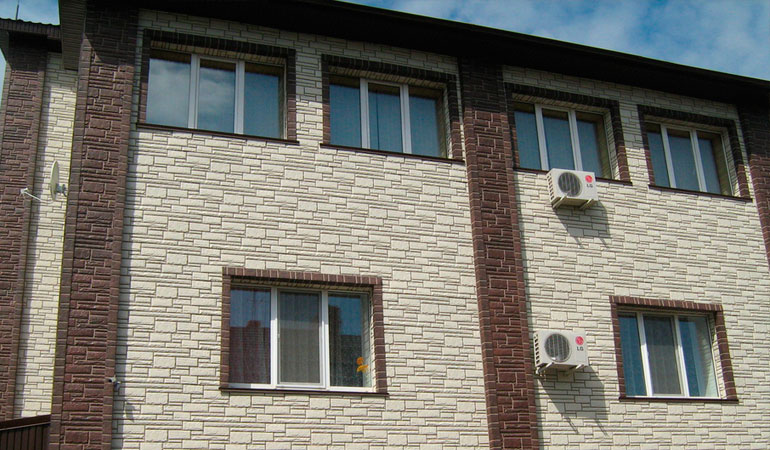
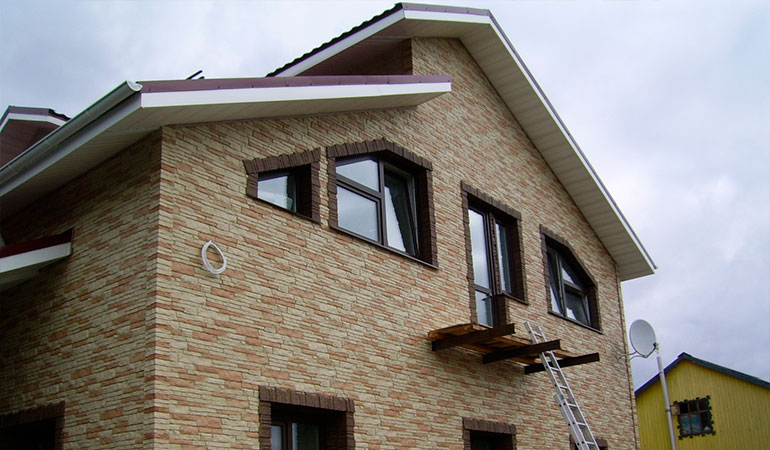


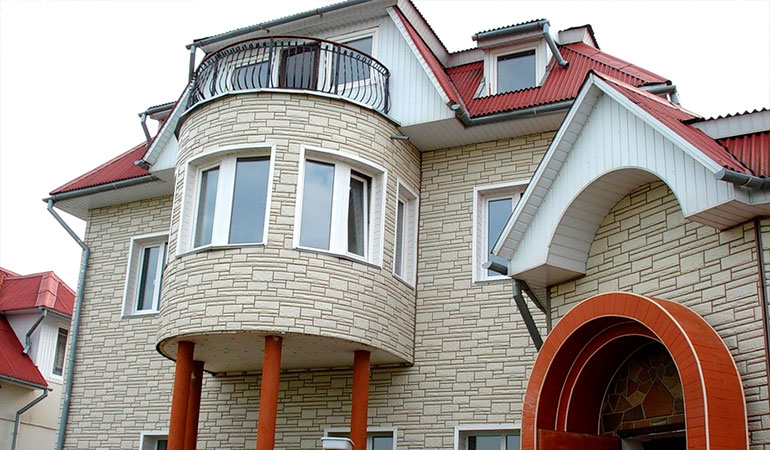
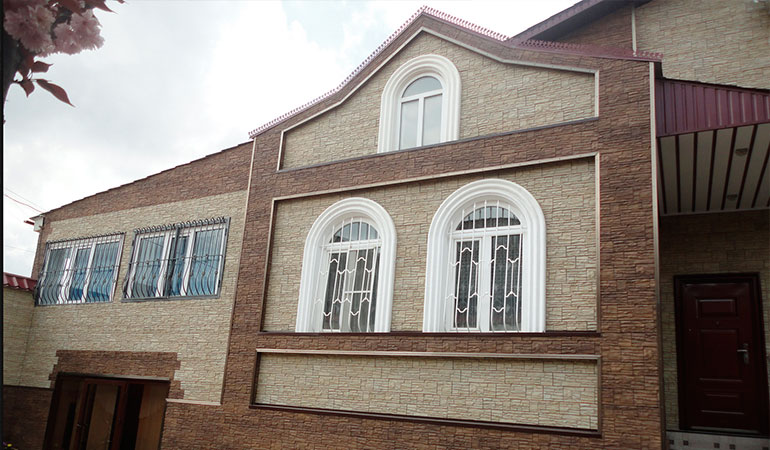
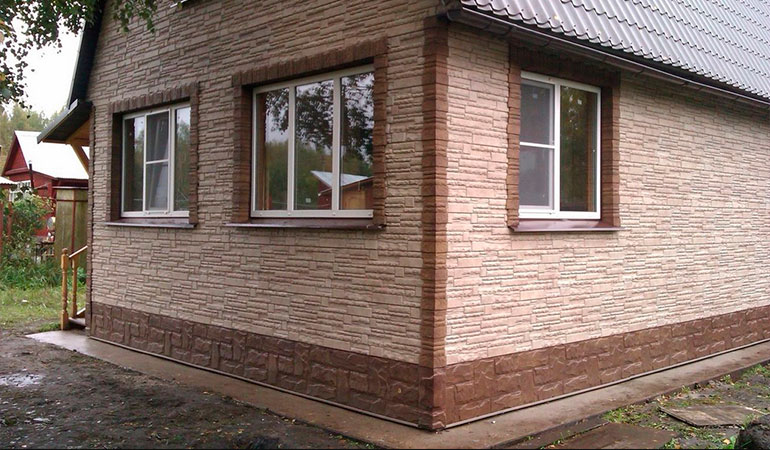
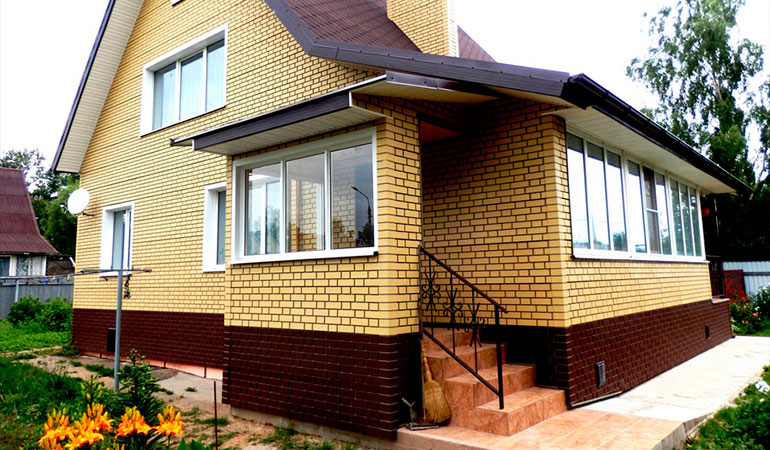
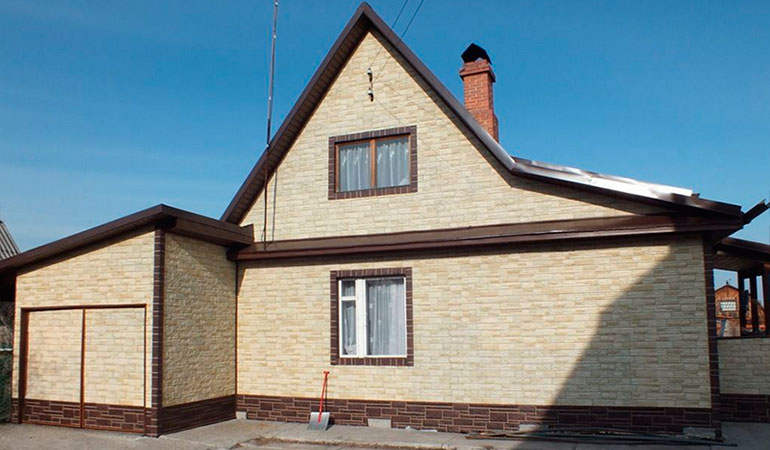

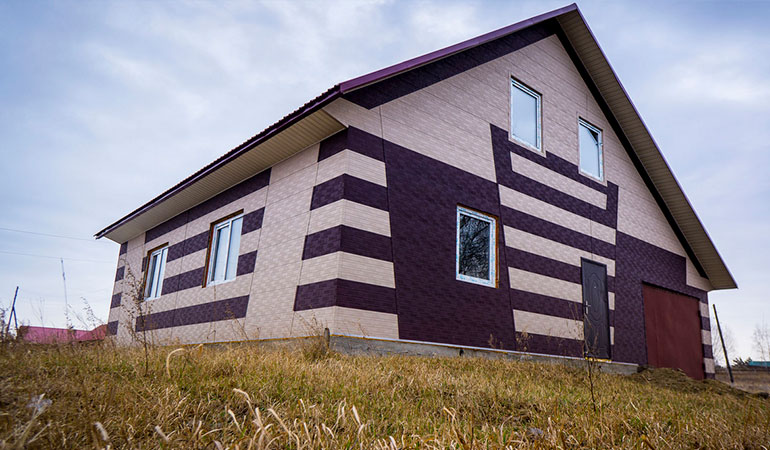
At overhaul any home milestone work is exterior decoration. Now the industry is producing ready-made panels for this from the most modern materials. Being an unsurpassed decoration for exterior decoration, facade panels reliably protect the house from dampness and cold. In addition, cladding panels are a good additional sound insulation for the facade of the house.
Now the market of building materials for house facades has the ability to satisfy the most fastidious customer. On it you can find facing panels for facades of various shapes and colors, various compositions and very different prices.
The most common types of facade panels include:
- plastic;
- From natural wood;
- From plywood;
- Insulation porous composition;
- fiber cement;
- Ceramic.
Even front wooden panels do not always stand up to competition. Natural, expensive compositions of facade panels have long been successfully replacing new, artificial materials. New inexpensive decorative panels for the facade are more durable and allow manufacturers to carry out a wide variety of artistic shaping of elements using inexpensive equipment.
Wall panels for the exterior facade usually do not require surface treatment - priming, puttying or painting. The desired properties of surfaces - color and shape - are set by the manufacturer already in the production process. This determines their building value. After all, decorative facade panels are easy to install, able to create an individual ornament without the involvement of design specialists.
Fiber cement panels
The main raw material for the production of fiber cement panels is cement with sand. Micro granules are added to them, which are able to regulate the humidity of the composition in the optimal range in any weather.
On both sides, these facade Wall panels covered with a protective compound, which is very durable. For many decades, the building has been protected from any adverse external factors. Aesthetic and beautiful on the outside, they remarkably endure temperature fluctuations.
Advantages of fiber cement exterior panels:
- High strength characteristics;
- Easy to mount on wall surfaces;
- Frost resistance (up to 100) cycles;
- Long service life;
- Heat resistance;
- Soundproofing ability;
- Low price range.
The special advantages of these panels for exterior decoration of the house include one hundred percent fire resistance.
Panels for masonry facades
Given their lightness, even the owner himself can perform the cladding of the house. No special tricks construction technologies it is not used.
Facade panels for plaster
Many people love, so they prefer to decorate with it or from a bar. It is clear that this is not convenient, the surface of the wall is not even. There is a demand, there will be an offer. Manufacturers have prepared New Product with imitation of the plaster system on the facade.
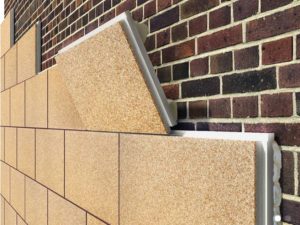 In fact, these are the same expanded polystyrene panels with an external decorative layer, which are made in stone or brick design. But now, on the same heat-insulating base, an imitation of a plaster facade is applied as a decorative layer. Why imitation - because in fact the outer layer is not made of plaster, but of plastic. It is painted and completely repeats the texture of the plaster-,. It is convenient to use such panels: they are mounted on glue, they immediately cover a large area, they are also a heater. Such plaster does not crack and chips do not appear after a strong hail. However, the house will not “breathe” and the microclimate will constantly have to be monitored, ventilated more often, it is better to install forced ventilation.
In fact, these are the same expanded polystyrene panels with an external decorative layer, which are made in stone or brick design. But now, on the same heat-insulating base, an imitation of a plaster facade is applied as a decorative layer. Why imitation - because in fact the outer layer is not made of plaster, but of plastic. It is painted and completely repeats the texture of the plaster-,. It is convenient to use such panels: they are mounted on glue, they immediately cover a large area, they are also a heater. Such plaster does not crack and chips do not appear after a strong hail. However, the house will not “breathe” and the microclimate will constantly have to be monitored, ventilated more often, it is better to install forced ventilation.
There are other types of facade panels for plastering. For example, manufacturers of Japanese 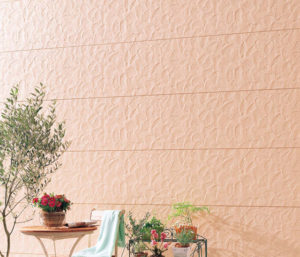 fiber cement panels have cement panels for plaster in their line. In their composition, they do not contain insulation, this issue will have to be addressed separately. But firocement panels are installed on the crate and are indented from the wall. And, if, at the bottom and at the top of the wall, some air is made, the air will circulate and constantly carry away moisture from the outside and condensate from the house. In such a house there will never be mold and wet walls inside the room.
fiber cement panels have cement panels for plaster in their line. In their composition, they do not contain insulation, this issue will have to be addressed separately. But firocement panels are installed on the crate and are indented from the wall. And, if, at the bottom and at the top of the wall, some air is made, the air will circulate and constantly carry away moisture from the outside and condensate from the house. In such a house there will never be mold and wet walls inside the room.
Which facade panels are better - based on expanded polystyrene or without this filler, you decide. However, the speed of installation of the facade is blocked by the operation of the facade, in which the insulation is made separately, the cladding is separate.
Facade panels under the brick
Brick buildings are traditionally reliable and aesthetic structures. They speak about the decent material level of the residents, and about good taste. But building a brick building has never been cheap. Expensive material is the brick itself, and the work of masons is also expensive.
Brick-like facade panels give the building the same look as a completely brick one. But the price, for example, of a panel board, is several times cheaper.
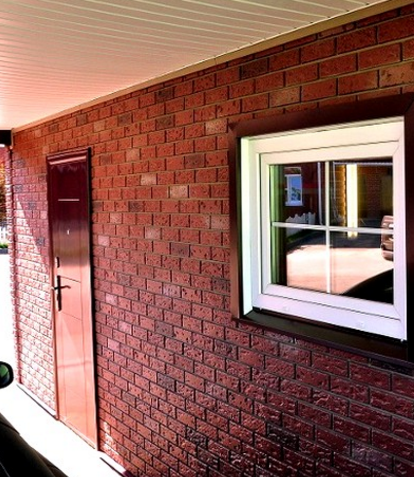
But the external difference between a brick building and a building lined with brick-like wall panels can only be seen close up or even only felt by touch.
Panels for exterior wall decoration under brick are made in monolithic and combined structural design. Combined panels consist of two layers - external plastic and internal polystyrene.
It is necessary to fasten the facade panels under the brick on the adhesive composition. If hot glue joints are used, they are practically inseparable, long-term.
Facade panels imitating brickwork will be much lower in price than ordinary decorative brick facing walls. And laying walls with decorative bricks is not a cheap task.
The panels can be used to cover the walls completely, or to decorate only the basement floors or levels of the building. To give the plinth a natural protrusion on the wall below, a special crate is made of metal profiles or wooden beams.
basement siding
A branded manufacturer of finishing materials supplies the construction market with basement siding facing panels that look like brick or natural masonry. Such panels give the plinth elements of houses the habitually solid look of a natural brick or stone building. The panels are designed to decorate the house from the outside, so they are not afraid of a humid climate, are easy to install, and are resistant to bright sunlight.
Product advantages: 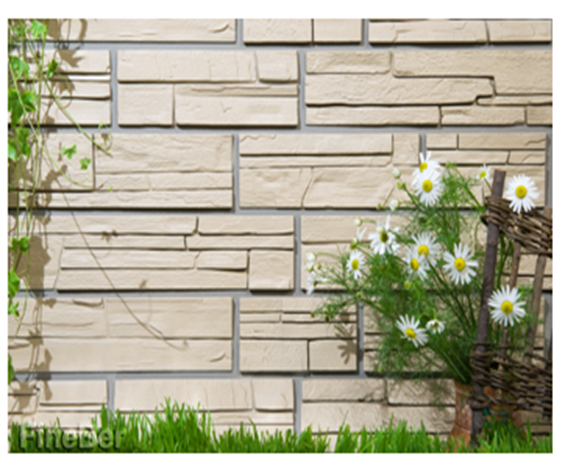
- Lower price compared to the price of cement panels for facades;
- Ease of installation minimum costs funds for further care;
- Perfect aesthetic appearance;
- Without loss of properties and appearance long service life;
- Full compliance with all existing quality standards;
- They are non-combustible facade panels.
For the manufacture of external cladding plinth panels, only high-quality raw materials are used, which fully comply with current environmental standards and building regulations.
Having a small thickness, facade panels without insulation are very durable. Given that the manufacturer guarantees a long service life of such panels, they are simply indispensable for finishing modern building facades. Of course, such an intuitive installation of facade panels can be done by hand, any savings are always a plus.
Any of the listed panel coverings of building facades is only a cheap substitute, an imitator of classical building technologies. However, if you think about such parameters of materials as thermal conductivity, moisture resistance and sound insulation, then it is quite possible to get the result of the opposite sense. Masterfully executed paneling of walls and facades of houses in these indicators can even surpass traditional methods of construction.
How to calculate facade panels for a house
The calculation of facade panels for a house is carried out according to the following instructions:
- First, we find out the area of \u200b\u200bthe cladding. To do this, multiply the perimeter of the house by its height. Then subtract the area of the openings.
- Then we find out the area of one panel. To do this, multiply the height of the panel by its width.
- And finally, you need to divide the first value by the second. Those. Divide the area of the house by the area of one panel. We get the number of panels in pieces. We add a small margin of 5%. We can go shopping.
If one of the varieties of your panel is the same corner panel, we consider it separately. To do this, multiply the corners of the house by the height of the building. Divide the resulting value by the height of the corner panel.

Now let's look at an example. Let's say we have a house 6 * 8m, 3m high, it has 2 windows 1.2 * 1.8m and one door 0.9 * 2m.
- We consider the area of \u200b\u200bcladding. The perimeter of a house is the sum of the lengths of its sides. We add 6+6+8+8=28m. Multiply by the height 28*3=84m. Now we consider the area of openings: windows 2pcs * (1.2 * 1.8) + 1 door (0.9 * 2) \u003d 4.32 (window area) + 1.8 (door area) \u003d 6.12 m - this is the area openings. Now we subtract from the cladding area the area of openings 84m - 6.12m = 77.88m.
- We find out the area of \u200b\u200bone panel. Height 0.648m, length 1.124m. So 0.648*1.124=0.73m.
- We calculate the number of panels in pieces. Divide the cladding area by the panel area 77.88m / 0.73m = 107 pcs. We add a stock of 5%, we get 112 pcs.
Now we consider the corner panels according to the same principle. And subtract the corners from ordinary panels.
For an accuracy of 100% in the number of panels, it is necessary to lay out the cladding on the drawing.
The simplest thing is to contact the manufacturer, as an accompaniment of the sale transaction, they will count for free and for sure everything will be of high quality to you.
Siding panels for finishing a house outside are one of the most popular types of facade decoration for private houses. Unlike many other cladding options, this material simultaneously possesses moisture protection, resistance to unstable temperature conditions and UV radiation, convenient installation and attractive appearance. Consider what types of siding panels exist and how to decorate the facade of a house with your own hands.
Varieties of panels
Siding panels differ from each other not only in color, texture and size, but also in the material of manufacture. According to this criterion, siding can be divided into several groups:
- Metal siding. It is made of aluminum and galvanized steel sheets, which are additionally coated with polymer compositions to increase the service life. This material does not deform with temperature changes, has frost resistance and mechanical strength. Its only drawback is that if the top protective layer is damaged, it begins to rust, which leads to a decrease in the attractiveness of the entire skin.
- polymer siding. Made from plastic, vinyl or PVC. Plastic panels are characterized by a wide range of colors, so you can easily choose the right facade color for any design idea.
- Fiber cement panels. They consist of a mixture of cement with cellulose and mineral additives. Unlike metal and plastic products, they do not fade in the sun, which allows them to maintain their aesthetic appearance for a long time. The disadvantages of this material include a fairly high moisture permeability. Therefore, during installation, you will additionally have to lay a layer of waterproofing.
- Sandwich panels. They have a multilayer structure: the outer layer (protective) consists of an alloy of aluminum, manganese and magnesium, and inside there are several layers of metal, between which a heater and a vapor barrier are placed. The appearance of such panels can imitate almost any building material (wood, brick, tile, etc.).

Preparatory work
Structurally, the siding of the house has a layered structure and consists of a heat-insulating material, a frame, waterproofing and decorative trim. At the same time, certain functions are assigned to each layer:
- insulation reduces the thermal conductivity of the walls, thereby keeping the heat inside the house during the cold season;
- the frame allows you to even out small differences in the heights of the base, lay the insulation and securely fasten the panels;
- waterproofing protects the heat-insulating material, frame and walls from moisture;
- decorative finishing gives the facade of the building an attractive look.
Facing the facade with siding begins with preparatory work. The first step is to calculate the required number of panels and all components. To do this, it is necessary to calculate the area of all elements of the building that will be sheathed (walls, basement, window slopes etc.), and then divide the resulting value by the area of one panel. For more accurate results, you will need to sketch.
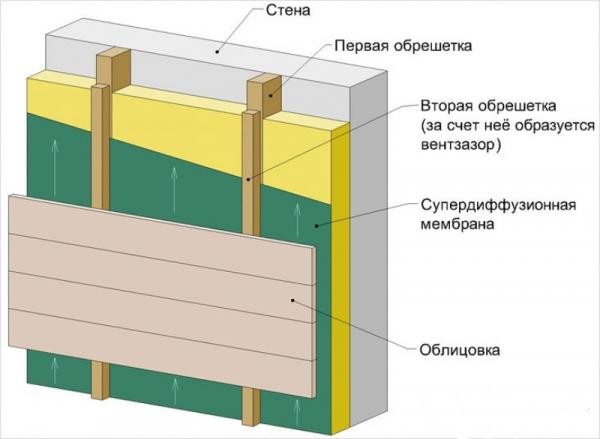
In addition to the panels themselves, for a successful installation work you will also need:
- electric drill;
- screwdriver;
- grinder or jigsaw;
- hammer;
- building level;
- roulette;
- wooden bars or metal profile for the frame;
- fasteners (dowels, screws, nails).
After all the materials are purchased, you can proceed to the preparation of the walls for sheathing. First, the base is cleaned of the old finish, after which the lanterns, downpipes, platbands and other protruding elements that will interfere with the conduction are dismantled. repair work. If the walls have small height differences, this is not a problem, since a properly installed crate will be able to align them.
Installation of battens and laying of siding panels
As a crate, you can use wooden bars with a section of 5x5 cm or a metal profile. Metal carcass has many advantages over wood, but its cost is somewhat higher, which in many cases is a decisive factor. To protect wood from the damaging effects of moisture, all wooden elements before installation, it is necessary to treat with a moisture-repellent agent.
The crate is installed perpendicular to the sheathing: if the panels for the exterior of the house will be laid horizontally, then the frame is mounted vertically, and vice versa. At the same time, the installation step of the guides is 30-40 cm. The bars are attached to the brick base with dowels, and to the wooden base with nails 10 cm long. The evenness of the crate must be constantly monitored using the building level, since the appearance of the finish will depend on this.
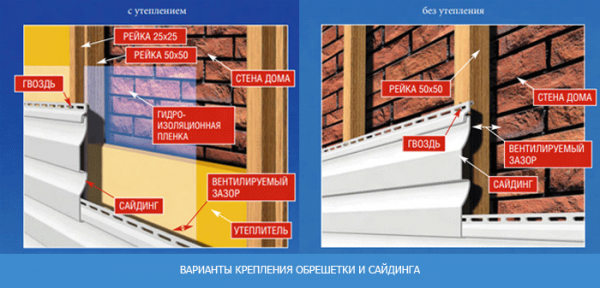
If the base is planned to be insulated, then a heater (mineral wool or expanded polystyrene) is laid between the frame, on top of which a waterproofing layer is mounted.
To create an air gap between the insulation and the siding, a counter-lattice is additionally attached to the frame (wooden bars with a section of 2.5x2.5 cm).
Finishing the facade begins with fixing the lower starting element, after which the corner strips are fixed. The perimeter of doors and windows is sheathed with a J-profile. External wall panels are installed in the starting and corner strips and fastened to the counter-lattice with screws or nails. Each subsequent sheet is connected to the previous "thorn-groove" method and additionally fixed with nails. At the last stage, the finishing bar is installed.
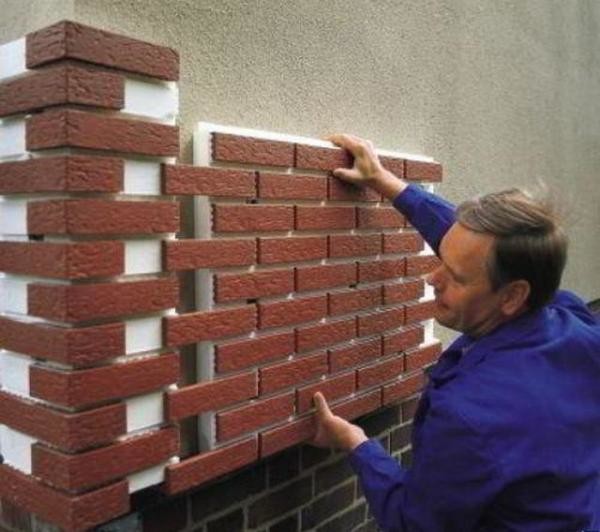
There is nothing complicated in sheathing a private house with siding panels, so you can handle all the work yourself. The main thing is to strictly follow the instructions and recommendations. Only in this case, the end result will please you with reliability and attractiveness for many years.
Related posts:
